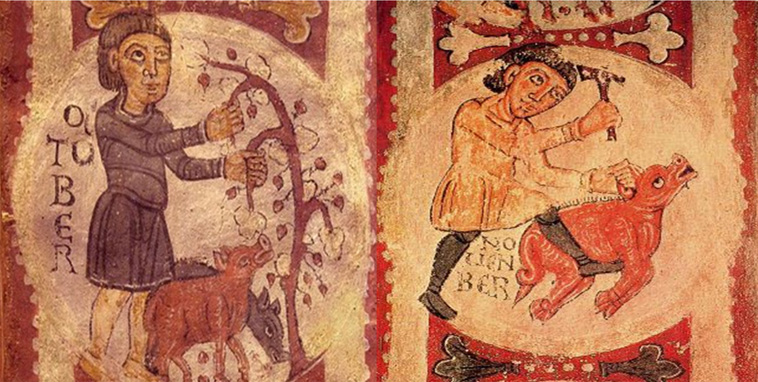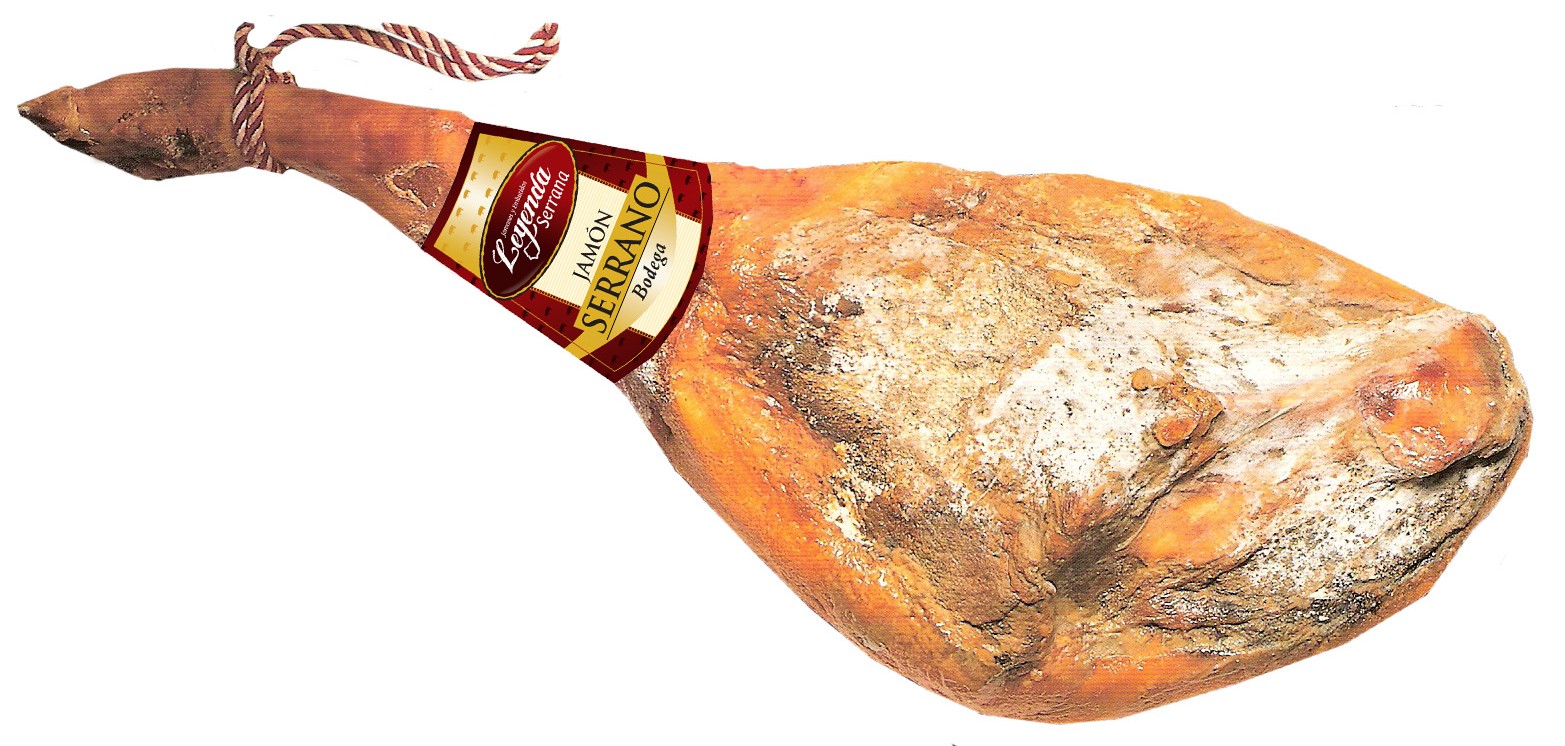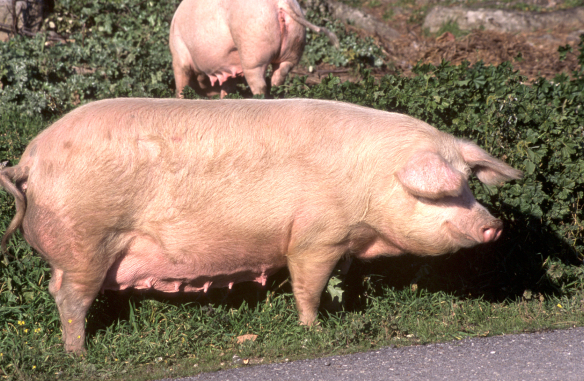
Generally speaking, the term jamón serrano refers to a leg of pork that has been preserved in the traditional way – first salted and then cured by exposure to mountain breezes for a period of between six and 36 months.
In common usage, in order to differentiate between hind-quarters (on which there is more, and better, lean meat) and fore-quarters, the word ‘jamón’ is used for the former and ‘paleta’ or ‘paletilla’ for the latter. On the evidence of the Real Academia Española database, it can be inferred that, although the word ‘jamón’ appears in Spanish texts from the late 16th century on, this Frenchified neologism (derived from the French ‘Jambon’) did not pass into general currency until the closing decades of the 19th century. However, it was then adopted so enthusiastically that it completely supplanted the traditional term ‘pernil’ (which appears in the occasional text from 1490 and is derived directly from the Latin ‘perna’, meaning : leg).
As for different categories of jamón, historical references do not differentiate between one breed of pig and another, but rather identify perniles by their place of provenance. This is because, until the 19th century, Spanish pigs were almost exclusively of the breeds known as ‘Ibérico’, and were raised on the extensive principle, feeding largely on acorns in the natural environment of the dehesa (wooded scrubland). In the last few decades, the term ‘Ibérico’ has come to denote products of a quality superior to those derived from other, intensively farmed, breeds. In the mid-20th century, foreign cross-breeds invaded the Spanish market, overtaking the native breeds and relegating them to a few pockets of traditional resistance.
The prehistory and history of serrano ham in Spain is, therefore, primarily the history of Ibérico ham.
 Nowadays, technically and legally speaking, the term ‘jamón serrano’ refers to a Guaranteed Traditional Specialty (GTS), a specific designation protected by EU Regulation 2082/92 in which a set of characteristics is defined, including both traditional and modern production techniques, and always with reference to non-Ibérico, white pig breeds. That said, some Protected Designations of Origin are recognized as guarantees of fine quality: Jamón de Teruel (from the Autonomous Community of Aragón) and Jamón de Trevélez (from the heart of the Granada’s Alpujarras, in Andalusia) are examples of quality products with a long tradition behind them, and that stand out from ‘jamones serranos’ in general.
Nowadays, technically and legally speaking, the term ‘jamón serrano’ refers to a Guaranteed Traditional Specialty (GTS), a specific designation protected by EU Regulation 2082/92 in which a set of characteristics is defined, including both traditional and modern production techniques, and always with reference to non-Ibérico, white pig breeds. That said, some Protected Designations of Origin are recognized as guarantees of fine quality: Jamón de Teruel (from the Autonomous Community of Aragón) and Jamón de Trevélez (from the heart of the Granada’s Alpujarras, in Andalusia) are examples of quality products with a long tradition behind them, and that stand out from ‘jamones serranos’ in general.
Although American-bred pigs were imported into Spain and other parts of Europe from the 16th century on, all were descendants of the Ibérico. The first Asian pigs (which fattened more readily), and other European varieties (Belgian White, Duroc-Jersey, Landrace, Large White, Pietrain…) for cross-breeding with Ibérico pigs, started arriving in the mid-18th century and throughout the 19th. Indeed, livestock farming made a gradual recovery between 1917 and 1936, with the selection of breeds, both Spanish and foreign, increasing and herds becoming larger.
 After the Spanish Civil War (1936–1939), the process went into reverse: between 1942 and 1950, the nation’s pig herd diminished by 20%. Improved economic conditions from the late 1950s on were reflected in an increasing demand for meat, especially pork, which was cheaper. Bigger demand resulted in extensive farming systems being thrust aside while fattening stations multiplied so that from 1959 to 1985 the situation known as the ‘traditional livestock crisis’ occurred, and within that the ‘Ibérico pig crisis’. Pork consumption increased spectacularly, as did the intensive production and industrialization required to achieve it, to such an extent that traditionally produced Ibérico ham accounted for a mere 5% of the total by 1985.
After the Spanish Civil War (1936–1939), the process went into reverse: between 1942 and 1950, the nation’s pig herd diminished by 20%. Improved economic conditions from the late 1950s on were reflected in an increasing demand for meat, especially pork, which was cheaper. Bigger demand resulted in extensive farming systems being thrust aside while fattening stations multiplied so that from 1959 to 1985 the situation known as the ‘traditional livestock crisis’ occurred, and within that the ‘Ibérico pig crisis’. Pork consumption increased spectacularly, as did the intensive production and industrialization required to achieve it, to such an extent that traditionally produced Ibérico ham accounted for a mere 5% of the total by 1985.
Significantly, in 1955, pregnant sows of foreign breeds Landrace and Large White represented only 1% of the total, while in 1974 they represented 81%, and in 1986 90%. Between 1986 and 2006, Spain’s total pork production increased by 44%, making it the second-biggest pork producer in the EU (15%), after Germany (22%).